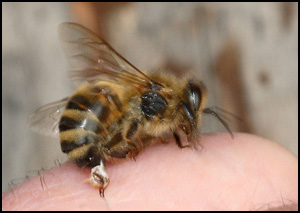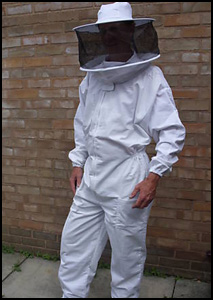Stings and protective clothing
-
The long evolution of the honeybee has given it an effective means for defending its stores of honey and its young – the sting! All worker bees have a sting, but use it only when provoked as they usually die in the process. The barbed stinger is torn off and remains in the skin whilst muscles on the stinger continue to pump venom into the wound.
All worker bees have a sting, but use it only when provoked as they usually die in the process. The barbed stinger is torn off and remains in the skin whilst muscles on the stinger continue to pump venom into the wound.Queen bees have a sting for a specialised use – fighting rival queens.
Drones have no sting.
Beekeeping involves opening up hives to look at the conditions inside. This may provoke the bees so it is necessary to wear protective clothing to avoid getting stung as far as possible.
 A veil covers the face, gauntlets cover the hands, boots protect the feet and thick overalls or equivalent clothing cover the rest of the body.
A veil covers the face, gauntlets cover the hands, boots protect the feet and thick overalls or equivalent clothing cover the rest of the body.Female beekeepers should note that a skirt is not suitable clothing in an apiary – when bees land on one’s legs they tend to crawl upwards. The solution to this is to wear thick trousers tucked into boots.
Useful Sites | Links
links
-
Log In
Registered Charity No. 1015801. © 2010 Vale & Downland Beekeepers Association. All rights reserved.Copyright Notice, Disclaimer and Privacy Statement
